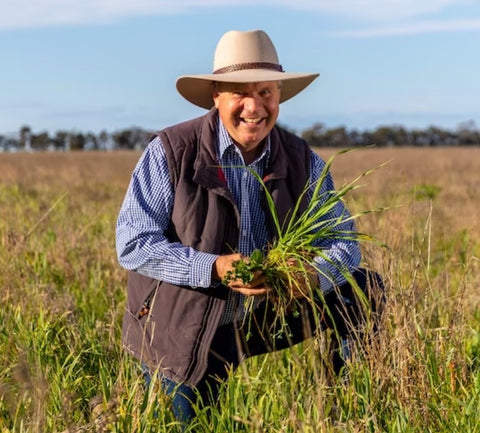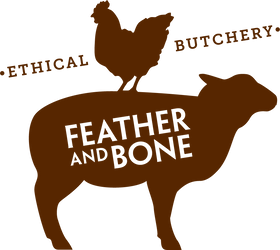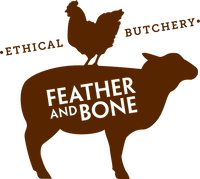'Lazy Farmer Lamb' from Bruce Maynard
Today we're excited to receive our third lamb delivery from fourth generation farmer Bruce Maynard's regenerative farm, Willydah, on the NSW Central Western Plains between Narromine and Trangie. Willydah is a mixed cropping and grazing farm and is a brilliant exemplar of the ways in which grazing ruminants compliment cropping to the advantage of the entire ecosystem.
Mr Bone visited the farm on a very wet day in August (see above) and there are lots of reasons to celebrate this new supplier.
Ovine terroir
First, Bruce's lambs are unique, resulting from his interest in biodiversity and his efforts to breed a locally adapted, composite, 'cleanskin' (shedding rather than wool-growing) breed that thrives in and is deeply compatible with the Willydah landscape and conditions.
This is what we would call 'ovine terroir'. It's right up our alley given our obsession with breeds and biodiversity and we think it's very cool.
Established in 2007, the breeding project incorporated a wide range of genetics - up to 15 different breeds across the whole spectrum of wool, hair and shedding types - in a bid to stabilise a locally adapted, cleanskin sheep. The result is a unique, multicoloured, sleek, meat breed perfectly suited to the geography and biology of the Western Plains of NSW. Like all breeding programmes, this is a work in progress but we can vouch for the results to date.

Regen rock star
Second, Bruce is himself a pretty interesting breed of farmer. Ironically nicknamed 'The Lazy Farmer' for championing non-interventionist agricultural practices, Bruce is renowned nationally and internationally for his 30 years of pioneering work in Stress Free Stockmanship, Self Herding, Grassland Grain growing and No Kill Cropping. In August, he was awarded the prestigious annual Bob Hawke Landcare Award which makes him top of the pops in the Australian agricultural scene.

It also expands his platform for advocating ecosystem management practices that allow farmers to grow more, consume less and provide a more diverse future for all of us.
Watch this lovely ABC Landline episode to find out more about Bruce, his fascinating cropping and planting systems and his crusade against the destructive affects of passive toxic agricultural chemical poisoning.

(While you're at it, read Gabrielle Chan's excellent Guardian Rural piece about agricultural chemicals and the cost of food. This is such a challenging issue. In December, we'll be on a panel with Dr Zach Bush, the American doctor, who has been campaigning internationally for years to expose the destructive effects of agricultural chemicals on human and planetary health.)
All the answers
Third, on the first page of our book, The Ethical Omnivore, we list the questions that we get asked every day about the products we sell. When I asked for more information about the farm, Bruce took it on himself to answer these questions for you and us, giving us a thorough and thoughtful response.
So below are the answers, from the farmer's mouth. Thanks, Bruce.
Where does it come from?
A 1600ha farm on the Central Western Plains of NSW between Narromine and Trangie.
How did it live?
Grazing across a diverse grassland/shrubland/woodland mix in large paddocks. It was allowed to remain in its social grouping with relatives until adulthood. The lamb was not administered synthetic chemicals of any kind and the plants that it grazed on were not treated with any poisons of any sort. Tails (and testicles in males) are not removed and the only intervention is the application of identifying eartags inserted into the ear.
How did it die?
After a short journey of 3 hours to Cowra the animal was humanely killed and initially processed. Then the carcasses are transported whole to Feather and Bone.
What impact did it have on climate change?
The Lamb was an integral part of one family’s direct work to reverse negative production CC effects. It was part of the groups of animals that apply targeted grazing disturbance to the landscape. These applications of animals to the plants (grasses, shrubs, trees) are to maximise the amount of plant growth and diversity thereby providing as much landscape function as possible to use and store Greenhouse gases. It also is important in being part of a food production system that does not consume large amounts of non-renewable resources.
What do the labels mean?
This lamb is Organically grown but not organically certified. It has been grazing amongst Grassland Grain systems that produce edible grains without the destruction of biodiversity.
How do I cook it?
In a loving way - appreciating that your consumption is supporting a family, community and world system that offers benefits for all.
How much should I eat?
According to your individual internal feedback - letting your own nutritional wisdom guide the amount and frequency of your enjoyment of this end product in combination with a wide variety of nourishing foods.
Should I eat meat at all?
Animals and their end products provide the strongest integration of community into country. Having livestock in the landscape leads to more human and environment interactions that strengthen commitment to country. Livestock use provides a range of disturbance factors within ecosystems that can be either positive or negative depending upon the production methods and the purchase of these lamb products supports those beneficial methods beyond just the supplying farms.
What is the stocking density?
The lambs range widely within paddocks that vary from 4 hectares to 100 hectares. They are unrestricted in their ability to express all their instinctive and habitual behaviours.
Chemical use
We have not used broad scale chemicals for 25 years (even in the worst of the Mouse or Locust plagues or other challenges). We do not need to use them.
How was it transported?
By dedicated sheep transporters to the central collection point then direct to meatworks.




Leave a comment